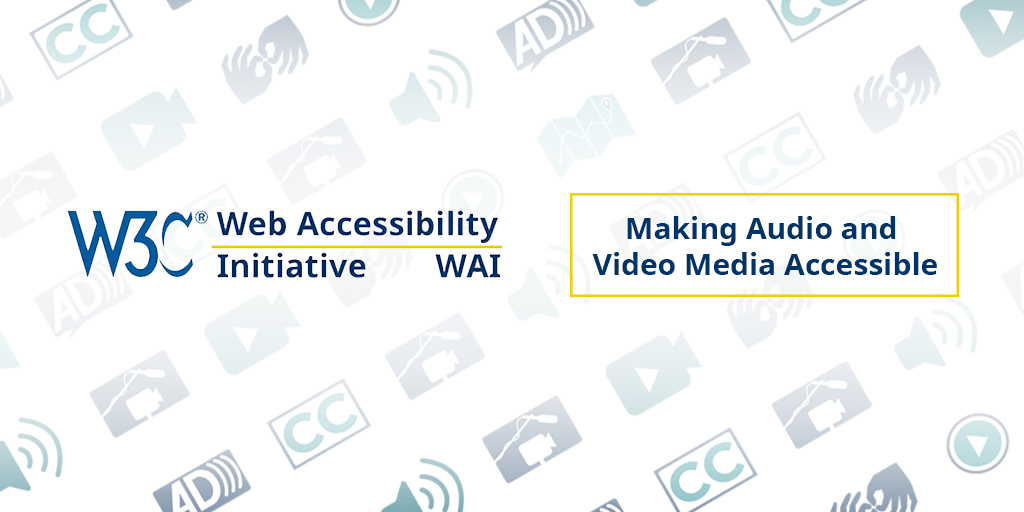Current Work
(updated monthly)
See What We're Working On – Accessibility Activities and Publications
For Wide Review: Collaboration Tools Accessibility User Requirements
(2024-Jul-10)
Collaboration Tools Accessibility User Requirements is ready for review. The document covers accessibility user needs, requirements, and scenarios for collaborative content creation and development tools. The solutions identified in this document are intended to influence the evolution of future accessibility guidelines, technical specifications, or features of collaboration tools and assistive technologies. They are also relevant to software developers who contribute to developing the collaborative experience. Questions for this review are in e-mail for CTAUR review. Please send any comments by 30 September 2024.
For Wide Review: Guidance on Applying WCAG 2 to Non-Web ICT (WCAG2ICT)
(2024-Jul-02)
WCAG2ICT is Guidance on Applying WCAG 2 to Non-Web Information and Communications Technologies (WCAG2ICT), including documents and software. The Draft is ready for final review before we publish it as a completed W3C Group Note. For an introduction, see the WCAG2ICT Overview. Please submit any comments by 6 August 2024.
Updated Resource: How People with Disabilities Use the Web
(2024-Jun-24)
How People with Disabilities Use the Web is updated with new user stories (personas) and new videos highlighting “Accessibility: It’s about people”. It describes tools and approaches that disabled people use to interact with technology and it covers barriers that people experience because of inaccessible digital technology. The resource helps developers, designers, content creators, and others understand the reasons behind creating accessible digital products. To quote the new videos: Whatever your role, “You can help make technology accessible to me.”
For Review: ACT Rules Format 1.1 - First Public Working Draft
(2024-Jun-18)
Accessibility Conformance Testing (ACT) Rules Format 1.1 Working Draft is available for review. The ACT Rules Format defines a format for writing accessibility test rules. It helps developers of automated testing tools and manual testing methodologies to write, share, and implement test rules. The test rules contribute to consistent testing for accessibility standards compliance. Changes from ACT Rules Format 1.0 include: new secondary accessibility requirements and allowing subjective applicability statements. For an introduction to ACT resources, see the ACT Overview. Please submit any comments by 18 August 2024.
WCAG 2.2 in Dutch: Authorized Translation Published
(2024-Jun-13)
Richtlijnen voor Toegankelijkheid van Webcontent (WCAG) 2.2, the Dutch Authorized Translation of Web Content Accessibility Guidelines (WCAG) 2.2, is now available, following completion of the W3C Authorized Translations process. Other translations of WAI resources are listed in All WAI Translations. WAI encourages translations in all languages. If you might be interesting in translating resources, see Translating WAI Resources. Thank you to all who contribute to translations.
WCAG 2.2 in Catalan: Authorized Translation Published
(2024-May-22)
Directrius per a l’accessibilitat del contingut web (WCAG) 2.2, the Catalan Authorized Translation of Web Content Accessibility Guidelines (WCAG) 2.2, is now available, following completion of the W3C Authorized Translations process. Other translations of WAI resources are listed in All WAI Translations. WAI encourages translations in all languages. If you might be interesting in translating resources, see Translating WAI Resources. Thank you to all who contribute to translations.
For Review: WCAG 3 Working Draft Outcomes
(2024-May-16)
An updated WCAG 3 Working Draft is ready for review. This draft includes potential outcomes that we are exploring. The purpose of this draft is to:
- better understand the scope of user needs and how they could be addressed in an accessibility standard,
- request assistance in identifying gaps, and
- request assistance locating and conducting research to validate or invalidate the drafted outcomes.
To learn more about this draft and review questions, please see the WCAG 3 Introduction.
See All News Subscribe to WAI News

